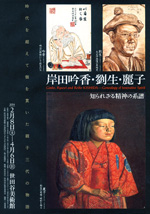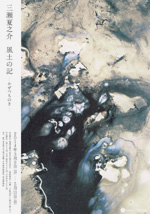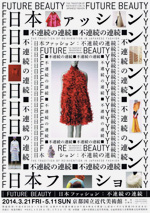 |
Picks is a monthly sampling of Japan's art scene, offering commentary by a variety of reviewers about exhibitions at museums and galleries in recent weeks, with an emphasis on contemporary art by young artists. |
 |
 |
|
|
 |
 |
 |
 |
| Ginko, Ryusei and Reiko Kishida: Genealogy of Innovative Spirit |
| 8 February - 6 April 2014 |
Setagaya Art Museum
(Tokyo) |
 |
| This show examines the achievements of three generations of Kishida spanning the Meiji, Taisho, and Showa eras. Best known is the artist Ryusei (1891-1929), who painted numerous portraits of his daughter Reiko (1914-1962), who herself went on to work in the theater and the arts. Less well known is that Ryusei's father Ginko (1833-1905) was a journalist who played a significant role in Japan's westernization process. Though the links between father and son seem tenuous (as evidenced by the separateness of their parts of this exhibition), the interwoven elements of the sections on Ryusei and Reiko speak to the closeness of their relationship. |
|
 |
|

|
 |
 |
 |
|
Natsunosuke Mise: Kaze Tsuchi no Ki |
| 9 March - 11 May 2014 |
Nara Prefecture Complex of Man'yo Culture
(Nara) |
 |
| The title translates literally as "Record of Wind and Soil," but it is written with the characters for fudo-ki, ancient records of provincial cultures. Innovative Nihonga artist Mise (b. 1973) currently lives in northeastern Japan but hails from Nara Prefecture, where he returns for this major solo exhibition. In these works one senses a keen eye for the culture and ambience of the land where he makes his home, expressed through his own personal filter. His paintings relentlessly scrutinize Japan and challenge preconceptions about Nihonga. |
|
|
 |
 |
|
Future Beauty: The Tradition of Reinvention in Japanese Fashion |
|
|
The National Museum of Modern Art, Kyoto
(Kyoto) |
 |
| Celebrating Japanese fashion's creativity and originality over the past half-century, as well as its solid underpinnings in the artistry of traditional Kyoto dyers and weavers, this show assembles over 100 items designed by such luminaries as Hanae Mori, Kenzo Takada, Issey Miyake, Rei Kawakubo, and Yohji Yamamoto. Film footage and other supplementary materials round out the presentation. |
|
|
|
|
|
|
|

|
 |
 |
|
 |
|
 |
|
| Akarui Hansen |
|
26 March - 1 April 2014
|
PULP
(Osaka) |
 |
| Part happening, part group exhibition, Akarui Hansen ("bright anti-war") is the expanded, Osaka edition of the street-art show Tanoshii Hansen ("happy anti-war") held in Tokyo a few months ago. Some 40 artists in various media present works on the theme of "opposing wars of all kinds." Notables include Hiroyuki Ohashi, Hitoshi Odajima, Akira Nishitake, Tetsuya Yamamoto (POTTO), Kawahiro Yurikov, BOM, fancomi, King Joe, Inori Kito, Hiroyuki Nisogi, and Eriko Yoshikawa. |
|

|
 |
 |
|
|
|
|
|
 |
|
|
|
|
 |
 |
|
| Torafu Architects: Please Staple Here. |
| 17 January - 13 February 2014 |
Creation Gallery G8
(Tokyo) |
 |
| Since founding Torafu in 2004, Koichi Suzuno and Shinya Kamuro have engaged in a wide range of endeavors, from architecture to product design to stage art. This show displays the full gamut of their oeuvre. Though occupying a small space, it manages to entertainingly engage the visitor who, by following the posted instructions, can actively participate in Torafu's exploits. |
|
 |
 |
 |
|
| 17th Japan Media Arts Festival |
| 5 - 16 February 2014 |
The National Art Center, Tokyo
(Tokyo) |
 |
| The gargantuan annual media arts event held its 17th Exhibition of Award Winning Works accompanied by a hefty menu of screenings, performances, and talks at various venues in the surrounding Roppongi neighborhood. As in previous years, entries were categorized as Art, Animation, Entertainment, or Manga, but this reviewer believes it's time the organizers dispensed with such rigid demarcations, which place increasingly meaningless constraints on the modes of expression introduced here. |
|
|
|
|
 |
|
|
 |
|